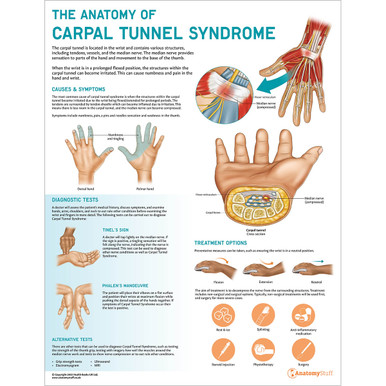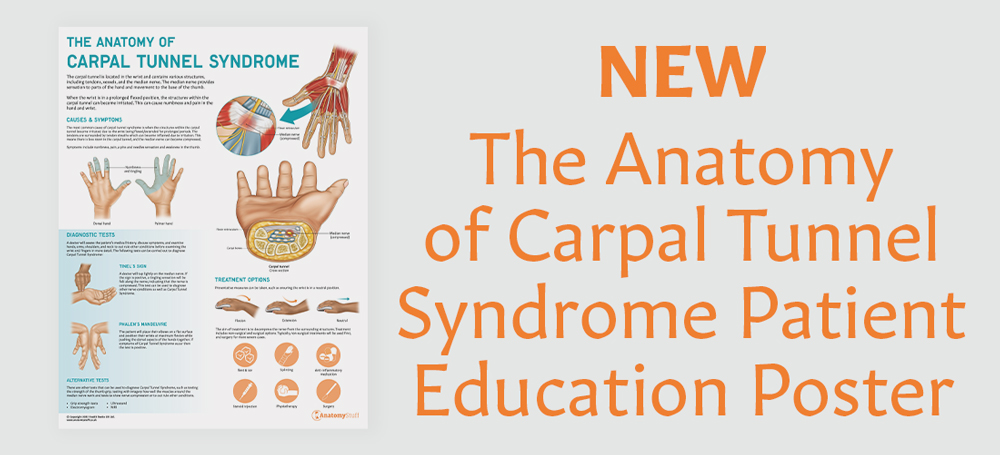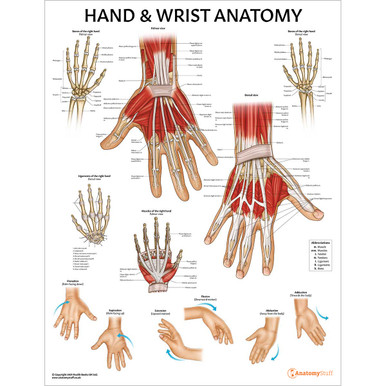Carpal Tunnel Syndrome
The carpal tunnel contains various structures, including tendons, vessels and the median nerve. When the wrist is in a prolonged flexed or extended position, it can irritate the structures within the carpal tunnel. This can cause numbness and pain in the hand and wrist. There are treatment options available for this condition, including exercises and injections.
Anatomy of Carpal Tunnel Syndrome
The carpal tunnel is located in the wrist and comprises two layers; tendons, nerves and vessels covered by the flexor retinaculum, and the carpal bones forming the tunnel’s other side. The median nerve travels through the carpal tunnel, providing sensation and motor function (movement) to the hand and thumb parts. For visual learners take a look at our Anatomy of Carpal Tunnel Syndrome chart.

What are the Causes & Symptoms of Carpal Tunnel Syndrome?
The leading cause of carpal tunnel syndrome is the wrist being in a flexed or extended position for a prolonged period, irritating the structures within the carpal tunnel. When the wrist is in a flexed/extended position or the hand is clenched repeatedly throughout the day, this can cause irritation. The tendons are surrounded by tendon sheaths which can become inflamed when irritation occurs. This means there is less room in the carpal tunnel, and the median nerve can become compressed. The main symptoms include numbness, pain, pins and needles and weakness in the thumb.
Free PDF Downloads
View AllWhat Tests can be taken to diagnose Carpal Tunnel Syndrome?
Tinel’s Sign
The clinician will tap lightly on the median nerve. If the sign is positive, a tingling sensation will be felt along the nerve, indicating that the nerve is compressed. This test can be used to diagnose other nerve conditions as well as carpal tunnel syndrome.
Phalen’s Manoeuvre
The patient will place their elbows on a flat surface and position their wrists at maximum flexion while pushing the dorsal aspects of the hands together. If symptoms of carpal tunnel syndrome occur, then the test is positive.
Alternative Tests
There are a few other tests besides the main two, including testing the grip strength, electromyogram, ultrasound or an MRI. Grip strength is tested because thumb grip weakness can be a symptom of carpal tunnel syndrome. Electromyograms test how well the muscles surrounding the median nerve are working, showing whether there is nerve compression. An ultrasound or an MRI can be used to see the nerves compression and also help rule out other conditions associated with the symptoms.
What’s the Treatment for Carpal Tunnel Syndrome?
Treatment aims to decompress the nerve from the surrounding structures. This can be done by keeping the wrist in a neutral position with a wrist splint to relieve pressure on the nerve. Preventative measures can also be used, such as stopping the hand and wrist motion that is causing the symptoms. Hand exercises can also be used to relieve the symptoms and release pressure from the nerve.
In cases where wrist splints are not successful, steroid injections can be used to reduce swelling of the structures around the nerve. Surgery can also be used to relieve pressure on the nerve when other treatment options are not working.
We have a wide range of posters, models and more available here, for all your professional or personal needs.
Related products
View All















